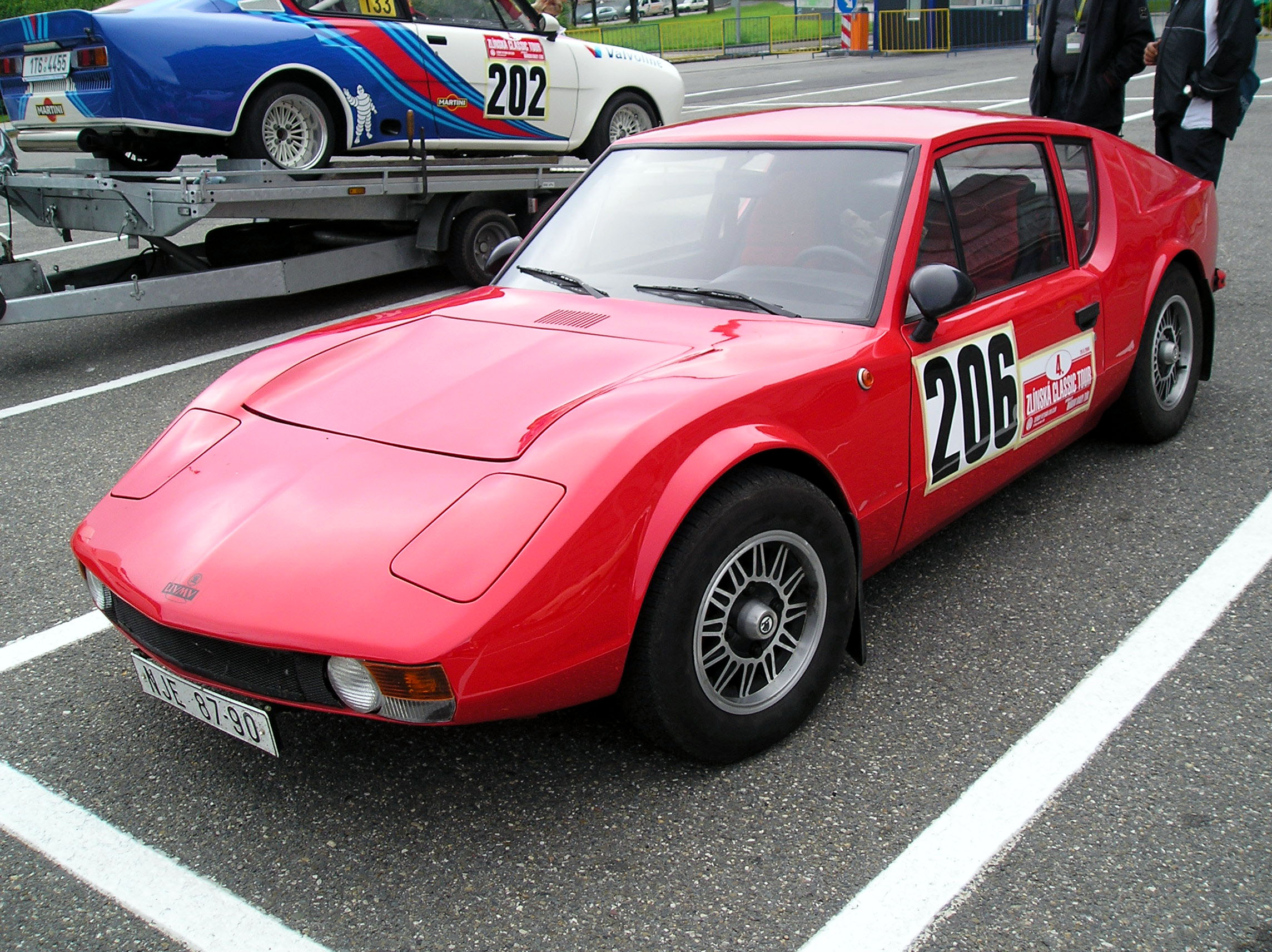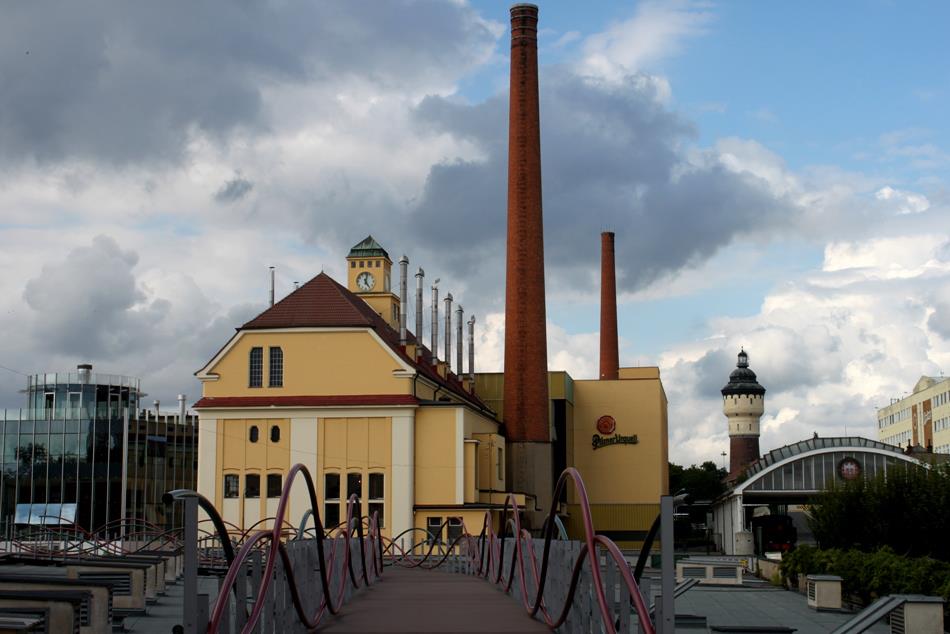|
ГљVMV 1100 GT
The Е koda 1100 GT (or Е koda 1100 GT) is a coupГ© automobile, car from Е koda Auto, AZNP made in 1970. It was exhibited at PlzeЕ€ Expo and the next year at the Geneva Motor Show. Internal dimensions and seating position were developed from the Saab Sonett#Sonett II, Saab Sonett II, Glas 1300 GT and Alfa Romeo GT Junior. Unlike the Saab it used the rear-engine, rear-wheel drive layout. It was powered by a modified Е koda 110 A2 engine. Only seven were ever built, three of them have registration numbers of the NovГЅ JiДЌГn District and two were variously rebuilt. Specifications * wheelbase: * size: x x * weight: * tyre: 14" Metzeler Monza 155 SR * motor: modified Е koda 110 A2, dual carburettor Weber 40 DCOE2 * displacement: 1,140 cc * max power: * top speed: * 0–100 km/h (62 mph): 13.7 seconds References External links web.daves.czretro.femat.cz (In Czech) Rear-engined vehicles, UVMV 1100 GT Е koda automobiles, 1100 Gt {{Classicpow-auto-stub ... [...More Info...] [...Related Items...] OR: [Wikipedia] [Google] [Baidu] |
CoupГ©
A coupe or coupГ© (, ) is a passenger car with a sloping or truncated rear roofline and typically with two doors. The term ''coupГ©'' was first applied to horse-drawn carriages for two passengers without rear-facing seats. It comes from the French past participle of , "cut". Some coupГ© cars only have two seats, while some also feature rear seats. However, these rear seats are usually lower quality and much smaller than those in the front. Furthermore, "A fixed-top two-door sports car would be best and most appropriately be termed a 'sports coupe' or 'sports coupГ©'". __TOC__ Etymology and pronunciation () is based on the past participle of the French verb ("to cut") and thus indicates a car which has been "cut" or made shorter than standard. It was first applied to horse-drawn carriages for two passengers without rear-facing seats. These or ("clipped carriages") were eventually clipping (phonetics), clipped to .. There are two common pronunciations in English: * () ... [...More Info...] [...Related Items...] OR: [Wikipedia] [Google] [Baidu] |
Automobile
A car, or an automobile, is a motor vehicle with wheels. Most definitions of cars state that they run primarily on roads, Car seat, seat one to eight people, have four wheels, and mainly transport private transport#Personal transport, people rather than cargo. There are around one billion cars in use worldwide. The French inventor Nicolas-Joseph Cugnot built the first steam-powered road vehicle in 1769, while the Swiss inventor François Isaac de Rivaz designed and constructed the first internal combustion-powered automobile in 1808. The modern car—a practical, marketable automobile for everyday use—was invented in 1886, when the German inventor Carl Benz patented his Benz Patent-Motorwagen. Commercial cars became widely available during the 20th century. The 1901 Oldsmobile Curved Dash and the 1908 Ford Model T, both American cars, are widely considered the first mass-produced and mass-affordable cars, respectively. Cars were rapidly adopted in the US, where they replac ... [...More Info...] [...Related Items...] OR: [Wikipedia] [Google] [Baidu] |
Е koda Auto
Škoda Auto Akciová společnost, a.s. (), often shortened to Škoda, is a Czech automobile manufacturer established in 1925 as the successor to Laurin & Klement and headquartered in Mladá Boleslav, Czech Republic. Škoda Works became State ownership, state owned in 1948. After the Velvet Revolution, it was gradually Privatization, privatized starting in 1991, eventually becoming a wholly owned subsidiary of the German multinational conglomerate Volkswagen Group in 2000. Škoda automobiles are sold in over 100 countries, and in 2018, total global sales reached 1.25 million units, an increase of 4.4% from the previous year. The operating profit was €1.6 billion in 2017, an increase of 34.6% over the previous year. As of 2017, Škoda's profit margin was the second-highest of all Volkswagen AG brands after Porsche. History The Škoda Works was founded by Czech engineer Emil von Škoda in 1859 in Plzeň, then in the Kingdom of Bohemia in the Austrian Empire, and was originally a ... [...More Info...] [...Related Items...] OR: [Wikipedia] [Google] [Baidu] |
PlzeЕ€
PlzeЕ€ (), also known in English and German as Pilsen (), is a city in the Czech Republic. It is the Statutory city (Czech Republic), fourth most populous city in the Czech Republic with about 188,000 inhabitants. It is located about west of Prague, at the confluence of four rivers: MЕѕe, Гљhlava, Гљslava and Radbuza, together forming the Berounka River. Founded as a royal city in the late 13th century, PlzeЕ€ became an important town for trade on routes linking Bohemia with Bavaria. By the 14th century it had grown to be the third largest city in Bohemia. The city was besieged three times during the 15th-century Hussite Wars, when it became a centre of resistance against the Hussites. During the Thirty Years' War in the early 17th century the city was temporarily occupied after the Siege of PlzeЕ€. In the 19th century, the city rapidly industrialised and became home to the Е koda Works, which became one of the most important engineering companies in Austria-Hungary and later ... [...More Info...] [...Related Items...] OR: [Wikipedia] [Google] [Baidu] |
Saab Sonett
The Saab Sonett is an automobile manufactured by Swedish automaker Saab between 1955 and 1957 and again between 1966 and 1974. The Sonett share its engines and other mechanical components with the Saab 93, 95 and 96 of the same era. It was mainly intended for the lucrative American export market and was only offered intermittently in the Swedish domestic market for the 1968 and 1972 model years. The first prototype, now known as the Sonett I, is a two-seat, open-top, lightweight roadster racer. Ten years later, the name was revived for the commercially distributed Sonett models II, V4, and III. __TOC__ Sonett I In the 1950s, Rolf Mellde—a Saab engine developer and race enthusiast—along with Lars Olov Olsson, Olle Lindkvist, and Gotta Svensson, designed a two-seat roadster prototype in a barn in Åsaka, near Trollhättan (the site of the main Saab manufacturing facility). The limited research-and-development project, with a total budget of only , first came to be kn ... [...More Info...] [...Related Items...] OR: [Wikipedia] [Google] [Baidu] |
Rear-engine, Rear-wheel Drive Layout
In automotive design, an RR, or rear-engine, rear-wheel-drive layout places both the engine and drive wheels at the rear of the vehicle. In contrast to the RMR layout, the center of mass of the engine is between the rear axle and the rear bumper. Although very common in transit buses and coaches due to the elimination of the drive shaft with low-floor buses, this layout has become increasingly rare in passenger cars. Overview Most of the traits of the RR configuration are shared with the mid-engine rear-wheel-drive, or MR. Placing the engine near the driven rear wheels allows for a physically smaller, lighter, less complex, and more efficient drivetrain, since there is no need for a driveshaft, and the differential can be integrated with the transmission, commonly referred to as a transaxle. The front-engine front-wheel-drive layout also has this advantage. Since the engine is typically the heaviest component of the car, putting it near the rear axle usually results ... [...More Info...] [...Related Items...] OR: [Wikipedia] [Google] [Baidu] |
NovГЅ JiДЌГn District
NovГЅ JiДЌГn District () is a district in the Moravian-Silesian Region of the Czech Republic. Its capital is the town of NovГЅ JiДЌГn. Administrative division NovГЅ JiДЌГn District is divided into five administrative districts of municipalities with extended competence: NovГЅ JiДЌГn, BГlovec, FrenЕЎtГЎt pod RadhoЕЎtД›m, KopЕ™ivnice and Odry. List of municipalities Towns are marked in bold and market towns in ''italics'': AlbrechtiДЌky - BartoЕЎovice - Bernartice nad Odrou - BГlov - BГlovec - BГtov - Bordovice - Bravantice - FrenЕЎtГЎt pod RadhoЕЎtД›m - Fulnek - HeЕ™manice u Oder - HeЕ™mГЎnky - HladkГ© ЕЅivotice - Hodslavice - HostaЕЎovice - JakubДЌovice nad Odrou - JesenГk nad Odrou - JistebnГk - KateЕ™inice - KopЕ™ivnice - Kujavy - KunГn - LibhoЕЎЕҐ - Lichnov - LubomД›Е™ - Mankovice - MoЕ™kov - MoЕЎnov - NovГЅ JiДЌГn - Odry - PetЕ™vald - PЕ™Гbor - PustД›jov - RybГ - Sedlnice - Е enov u NovГ©ho JiДЌГna - Skotnice - Slatina - '' Sp ... [...More Info...] [...Related Items...] OR: [Wikipedia] [Google] [Baidu] |
Е koda 110 R
The Е koda 110R was a rear-engined, rear-wheel drive car produced by Czechoslovakian manufacturer AZNP in Kvasiny between 1970 and 1980. During those ten years, a total of 56,902 coupГ©s were made. The 110R CoupГ© succeeded the sporty Е koda 1000 MBX/1100 MBX. It was powered by an uprated SAE, (DIN) version of Е koda's 720-type OHV four-cylinder 1.1-litre (1107 cc) engine (this same engine was shared with the Е koda 110LS saloon, following its introduction in 1971). With a four-speed manual gearbox, the 110R could reach a top speed of and accelerate to 100 km/h (62 mph) in 18.5 seconds. Its design closely mirrored that of the related 100 and 110 saloons, but with only two doors and a distinctive fastback rear. During most of its production period, the 110R featured four headlights, but in the earliest years it had only two. Production ended in 1980 to make way for its successor, the Е koda Garde (the Coupe-based version of the Е koda 105/120 series), which was in ... [...More Info...] [...Related Items...] OR: [Wikipedia] [Google] [Baidu] |
Rear-engined Vehicles
In automobile design, a rear-engine design layout places the engine at the rear of the vehicle. The center of gravity of the engine itself is behind the rear axle. This is not to be confused with the center of gravity of the whole vehicle, as an imbalance of such proportions would make it impossible to keep the front wheels on the ground. Rear-engined vehicles almost always have a rear-wheel drive car layout, but some are four wheel drive. This layout has the following features: *Packaging: since there is no need for a transmission tunnel, the floor can be flat. *Rear traction: having the engine located over the driven wheels increases downward pressure, which is helpful for grip on loose surfaces, although can be prone to oversteer. *Simplicity of manufacture: the engine is near the driven wheels, and the transmission can be merged with the differential to save space. This layout was once popular in small, inexpensive cars and light commercial vehicles. Today most car makers ... [...More Info...] [...Related Items...] OR: [Wikipedia] [Google] [Baidu] |







